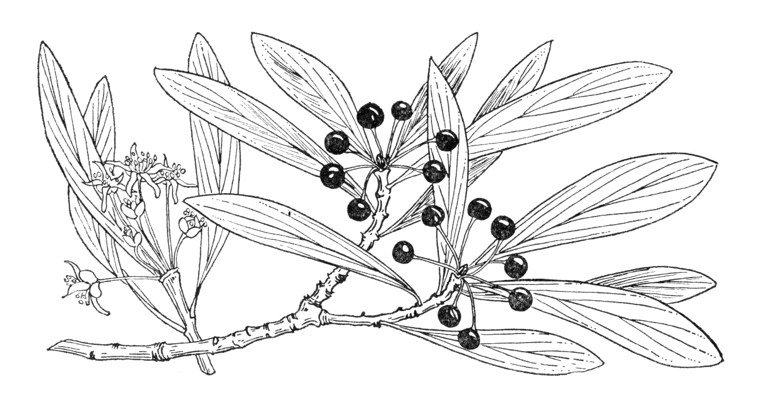A dense evergreen shrub or small tree attaining 15 ft high in the wild state. Young stems rich crimson and remaining so for a year or more. Leaves elliptic to oblanceolate, bluntly or sharply pointed, tapered at the base into a short stalk, which is coloured like the stems; they are variable in size, from 3⁄5 to 3 in. or more long, 2⁄5 to 13⁄5 in. wide; medium green and glossy above, paler beneath, leathery. Flowers dioecious, about 1⁄2 in. wide, produced in April and May in fascicles at the ends of the previous season’s growths; sepals deciduous, 1⁄5 in. long; petals two to eight, whitish, linear or narrowly oblanceolate; female flowers with a single carpel; male flowers with twenty to twenty-five buff-coloured stamens. Fruit black.
Native of Tasmania, where it is very abundant, and of Victoria and New South Wales; introduced in 1843. The leaves are aromatic and have a pungent, peppery taste; the dried fruits have been used as a substitute for pepper. Although reputed to be tender, this species seems to have survived the winters of 1961-3 in most of the few gardens where it is grown. The form introduced by Comber in 1929 certainly appears to be quite hardy, given shelter from cold, drying winds. It is of dense, broadly columnar habit and has leaves to about 13⁄4 in. long.
The mountain pepper is a handsome evergreen, very distinct in the deep red tints that suffuse the stems, buds and petioles, and might well be tried as a hedge-plant in sheltered gardens (it is already being used as such in Ireland). The female flowers are inconspicuous, but the male, with their dense clusters of pinkish-buff stamens, are quite pretty.


